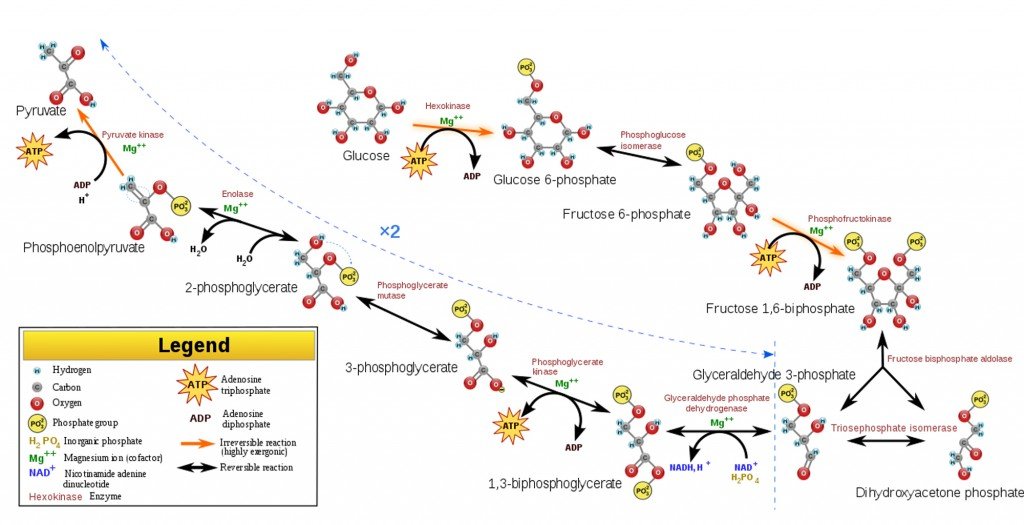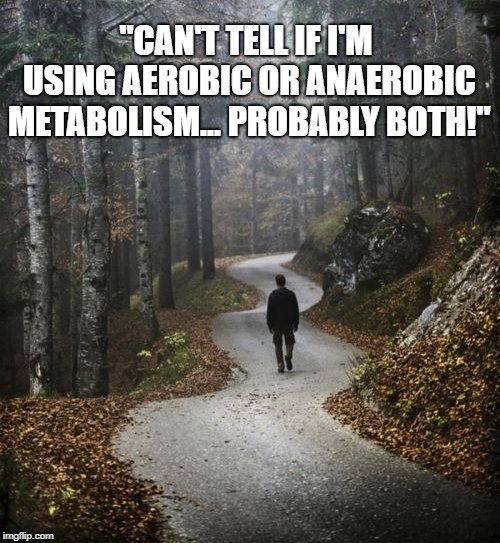Table of Contents (click to expand)
Metabolism is all the chemical reactions that happen inside a body. Aerobic metabolism is when the body produces energy (in the form of ATP) using oxygen. Anarobic metabolism is when the body produces energy without oxygen. Aerobic metabolism is more efficient at creating energy than anaerobic metabolism.
Although many people fail to realize this, every day that you wake up and experience existence is rather incredible. Every action of our bodies, from pumping blood around our organs and inhaling oxygen to flexing our fingers and climbing a flight of stairs, requires energy. For every living creature, the acquisition, transformation and expenditure of energy is critical to survival. The generation of that energy through chemical processes in an organism is known as cellular metabolism.
What Is Cellular Metabolism?
Essentially, metabolism is all the chemical reactions that happen inside a body. When we look at metabolism on a cellular level, we call it cellular metabolism. These reactions, mostly catalysed by enzymes, can be categorized into many different ways depending on what process they are a part of.
For this article we will refer to the energy or fuel metabolism which is those enzymatic reactions that generate energy for the body from the food we eat.
The food we eat – carbohydrates, proteins, and fats, get broken down to form ATP (Adenosine Triphosphate), the body’s energy currency. ATP is the molecule that gives the body energy to do other processes, like exercise, read, think, dance and basically live.

This breakdown that leads to generation of energy can happen by two ways: aerobic metabolism or anaerobic metabolism. These two sides of the metabolic coin are quite different, despite beginning with the same raw materials, but a balance of these two processes are essential for survival!
Also Read: What Is Metabolism, Anabolism And Catabolism?
Aerobic Metabolism Vs Anaerobic Metabolism
This heading may be slightly misleading, suggesting that these two forms of metabolism are in opposition, when in fact, they are closely linked and interdependent in certain ways. The key difference between the two is that aerobic metabolism occurs in the presence of oxygen, while anaerobic metabolism does not.
Aerobic Metabolism
Although aerobic metabolism is the slower of the two processes, it is far more prevalent and essential for our daily functioning. Representing about 90% of all cellular metabolism, aerobic metabolism is the process by which fats and carbohydrates are converted into usable energy in the form of ATP (adenosine triphosphate). Aerobic metabolism is counted on for the production of energy that can support sustained energetic needs, e.g., walking, jogging, daily exertions.
The conversion of carbohydrates into energy is required every day, for all of your basic functional needs. This is why aerobic metabolism occurs constantly in the body. Aerobic metabolism is also the only means by which your body can extract energy from fat. The amino acids from proteins when broken down for fuel, which mainly happens when the body is short on carbohydrates or fats like during starvation or diabetes, can either be converted to glucose or glycogen, or ketone bodies through a process called ketosis.

Despite being the slower of the two processes, aerobic metabolism is very efficient, and is able to squeeze 34 molecules of ATP from a single molecule of glucose. The additional byproducts include carbon dioxide and water. Aerobic metabolism consists of two different pathways, the Krebs cycle and the electron transport chain, both of which occur in the mitochondria, the energy factories of cells. The raw materials required for these two stages include water and oxygen, but the step preceding these aerobic processes is none other than anaerobic glycolysis, which we will explain below.
Also Read: What Are The Different Steps In Cellular Respiration?
Anaerobic Metabolism
Unlike the form explained above, anaerobic metabolism does not require the presence of oxygen to convert raw materials into energy. However, anaerobic glycolysis is far less efficient, producing only two molecules of ATP, in comparison to aerobic metabolism’s impressive 34.
The body relies on anaerobic respiration when a sudden burst of energy is required in a short amount of time. For example, imagine that you are a sprinter or a weightlifter; your physical demands are usually intense, but only for a limited amount of time. Since aerobic metabolism takes more time, the body uses anaerobic metabolism to generate energy for immediate use from carbohydrates, but not fat or protein. Beginning with a single molecule of glucose, the glycolysis process unfolds in the cytoplasm of a cell, and does not require any organelles.
Additionally, for activities such as sprinting or weightlifting, the body is in short supply of oxygen. The heart is pumping blood as fast as it can, but not enough and not in time to satisfy the needs of the muscles or other cells.

Unfortunately, one of the byproducts of anaerobic metabolism is lactic acid, which can cause fatigue. A rapid buildup of lactic acid is what causes cramps in athletes who push themselves too hard without properly warming up – or when the body fails to balance aerobic and anaerobic metabolism.
The body’s default is aerobic metabolism since it is so much more efficient than anaerobic (unless you are an anaerobic bacteria, then oxygen could kill you). Anaerobic respiration is there in case of emergency situations until the body can get back to its original oxygen dependent self.
Not So Different After All…
While the volume and variety of the end products vary, aerobic and anaerobic metabolism are intimately connected. As mentioned earlier, glycolysis is the first step that leads into aerobic respiration, and is therefore happening all the time, just like aerobic metabolism. Essentially, the body needs to “warm up” into the aerobic metabolism of fats, so it begins with pure carbohydrate conversion in the cytoplasm and then transitions into aerobic metabolism.
You don’t notice the negative byproducts of anaerobic metabolism in most cases because your body can eliminate the byproducts faster than you can produce them. Imagine that you take a long, leisurely walk through the park. Your body will be undergoing anaerobic and aerobic metabolism, but provided you have eaten enough food that morning, are moving at a normal pace, and not overly exerting yourself, you probably won’t break a sweat or develop a lactic acid cramp. So long as the body’s aerobic metabolic pathways can keep up with the body’s demands, anaerobic metabolism can take a backseat. When the energy produced by aerobic processes is insufficient, the anaerobic processes take on a bigger role to fill the demand.

The two processes are clearly intertwined, and equally important. Without aerobic respiration, we would lack the constant sources of energy needed to walk, breathe, work, speak and drive a car. Without anaerobic respiration, our ability to snap into action, such as during a fight-or-flight scenario, would be severely compromised. All in all, we should be eternally grateful for both sides of the metabolic pathway, and the clever path of evolution that allows us to live!
How well do you understand the article above!

